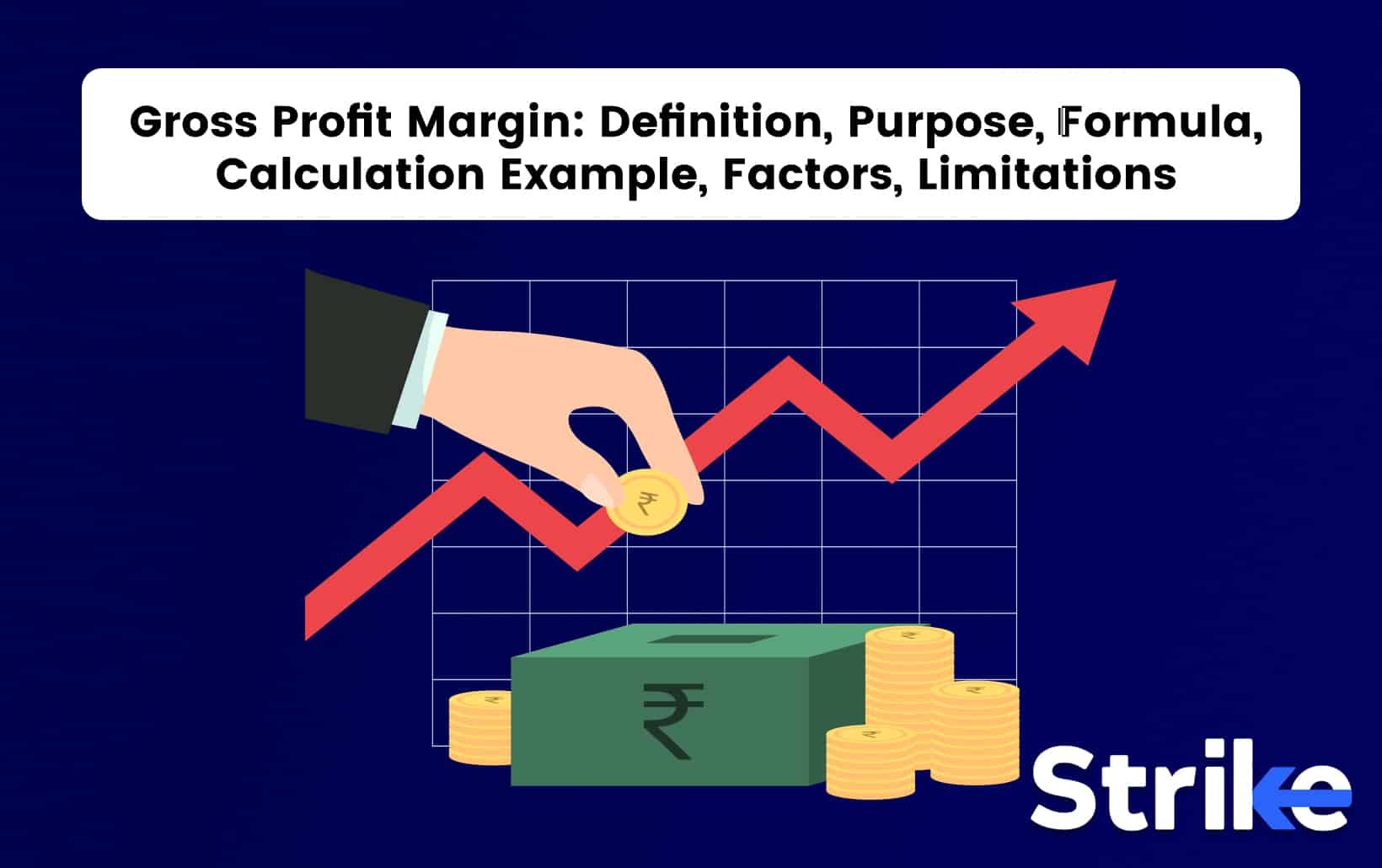
Gross profit margin is a financial metric that provides valuable insights into a company’s underlying profitability and competitive position. Gross profit margin demonstrates the percentage of each rupee of sales revenue that ultimately flows to the bottom line after direct costs are deducted. This offers a lens into pricing power, production efficiency, and cost management abilities over time trends.
Expanding margins signal growing profits through improved pricing or cost controls while declining margins raise questions about pressures eroding performance. Management execution is also revealed through their ability to optimize this balance sheet barometer. Contextualizing margins against industry peers and historical ranges provides a perspective on competitive strengths. As the genesis of profits, scrutinizing gross profit margin forms an essential component of the fundamental analysis informing prudent capital allocation decisions in public markets.
What is the gross profit margin?
Gross profit margin is the percentage of Revenue remaining after deducting the costs associated with producing and selling goods and services. Gross profit margin is an important metric that investors use to evaluate the financial health and performance of companies. Gross profit margin offers insights into a company’s pricing strategies and production efficiency. Investors like to see healthy gross margins because it means a company is generating substantial profits to cover operating expenses and provide returns to shareholders.
What is the purpose of gross profit margin?
The purpose of gross profit margin is to measure a company’s profitability before accounting for overhead expenses. It measures how much profit a company generates after accounting for the direct costs of goods sold before subtracting operating expenses like R&D, salaries, rent, etc. Gross margin is able to provide insight into a company’s competitive position, pricing power, and ability to deliver profitable growth over time. Companies with wider gross margins have more flexibility to cover fixed costs, invest in new products and capacity, and reward shareholders.
Declining gross margins over time sometimes signal issues like increased competition, supply chain problems, or mismanagement. Specifically, analysts sometimes look at historical gross margin trends within an industry or for a company. Software and pharma stocks tend to have very high gross margins due to minimal incremental costs to distribute digital or intellectual property assets. Consumer staples like beverages, personal care, and food products also tend to earn robust gross margins thanks to strong brands allowing for premium pricing.
What is the formula for gross profit margin?
The gross profit margin formula is calculated by dividing gross profit by total Revenue, which shows what percentage of Revenue is left over after subtracting the cost of goods sold.
Gross Profit Margin = (Revenue – Cost of Goods Sold) / Revenue
While conceptually simple, properly analyzing this metric takes a bit of work for investors researching stock market opportunities.
Gross profit specifically refers to what is left from product sales after deducting direct production costs or the cost of goods sold (COGS). This includes raw materials, labor, manufacturing overhead expenses, and any other direct costs incurred in making the products or delivering the services sold by the company.
By contrast, Revenue is the total amount of sales brought in by the company before any costs or expenses are deducted. In the formula, Revenue is the output produced, and COGS is the input cost directly tied to generating that output. The difference between the two is the gross profit.
The reason gross margin matters to investors is it provides insights into a company’s profitability and how efficiently it converts inputs like raw materials and labor into sellable products demanded by the market.
What is an example of gross profit margin calculation?
Let’s calculate the gross profit margin for Hindustan Unilever Limited (HUL). This company sells a wide range of products, including soap, tea, detergent, and food.
As a publicly listed company, HUL shares trade on the Bombay Stock Exchange and the National Stock Exchange of India. Investors routinely evaluate metrics like gross margin when deciding whether to invest in HUL stock or compare it to peers.
The first step is gathering the needed inputs for the formula, as stated below.
Gross Profit Margin = (Revenue – Cost of Goods Sold) / Revenue
According to HUL’s latest annual report, its Revenue from operations was ₹45,311 crores. This includes sales of all products and services. The cost of materials consumed was ₹18,698 crores. This accounts for raw materials like vegetable oils for soaps, packaging materials, tea leaves, etc. In addition, purchases of stock-in-trade amounted to ₹7,761 crores. This refers to finished products bought from third parties and sold directly without further processing. These two expense items combine to give the cost of goods sold (COGS) of ₹26,459 crores.
Plugging this into the formula as stated below.
Gross Profit = Net Revenue – COGS
= ₹45,311 crores – ₹26,459 crores
= ₹18,852 crores
Gross Margin = (Gross Profit / Revenue) x 100
= (₹18,852 crores / ₹45,311 crores) x 100
= 41.6%
So, HUL had a gross margin of 41.6% last financial year. This shows over 40% of Revenue flowed through as gross profit after deducting direct costs of production.
For investors, this gross margin percentage reveals how well HUL manages raw material costs and conversion efficiency in fragmented consumer product categories.
What are the factors affecting gross profit margin?
The main factors affecting a company’s gross profit margin are COGS, Price, Units sold, Fixed & variable costs, and Operating expenses.
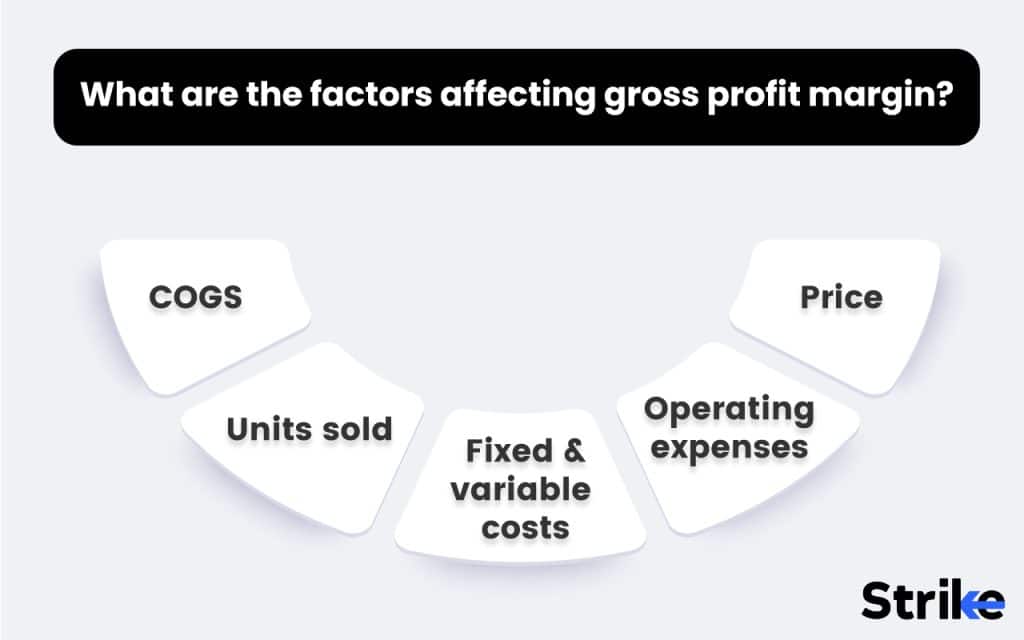
1.COGS
Cost of Goods Sold (COGS) is an important financial metric that investors analyze when evaluating stocks, especially for companies that manufacture and sell products. COGS refers to the direct costs attributable to the production of goods sold by a company. This includes the cost of raw materials, direct labor costs, and overhead costs directly related to production.
Analyzing COGS as a percentage of Revenue or gross profit provides insights into a company’s profitability and efficiency. A high COGS as a percentage of Revenue means the company has less money left over to cover operating expenses and net profit. This could be a sign of inefficiency in production or purchasing. Investors typically want to see COGS staying steady or decreasing as a percentage of Revenue over time, as this shows the company is improving profit margins.
2. Price
The price a company is able to charge for its products or services directly affects how much gross profit it is able to earn. In a competitive market, companies have to strike a balance between pricing their offerings high enough to earn strong margins versus low enough to attract sufficient demand from customers. For public companies listed on the stock market, pricing decisions significantly influence investors’ views on the business and its future profit potential. It sometimes is able to improve its gross margins in the short term when a company raises prices. However, higher prices could also reduce demand for the company’s offerings over time, leading to lower sales and Revenue. Investors approve of price hikes if they appear necessary to maintain healthy margins in the face of rising costs. However, drastic price increases could signal desperation and an inability to control costs.
On the other hand, companies that slash prices sometimes do so in order to stay competitive or maintain market share. Lower prices tend to stimulate consumer demand and grow the customer base. However, they put pressure on gross margins and reduced profitability per unit sold. Investors sometimes see deep price discounting as a warning sign that the company’s products are not differentiated or compelling enough to command full price. Ongoing price cuts sometimes also point to a commoditized market with intense competition on price rather than quality or features.
3. Units sold
As unit sales increase, companies with high fixed costs and low variable costs per unit benefit from positive operating leverage that is able to expand gross margins. Businesses like software, biotech, and pharmaceuticals often have very high fixed costs related to research, development, and infrastructure but relatively low variable costs for manufacturing and distribution. As their sales volume grows, these large fixed costs get spread over a greater number of units produced and sold while the incremental variable cost per additional unit remains minimal. This dynamic directly translates into improved gross margin performance for companies that have the right cost structure. Investors seek out stocks that are able to leverage growing unit volumes to widen profit margins over time through positive operating leverage.
On the other hand, companies with relatively low fixed costs but high variable costs tied to each individual unit sold sometimes experience declining gross margins as total volume increases. Examples include retailers, restaurants, consumer products companies, and other businesses with major variable costs that grow in proportion to output, like sales commissions, raw materials, transportation, and labor. While higher unit production initially provides opportunities to negotiate quantity discounts on some variable inputs, at very large scales, the accumulating variable costs often overwhelm those savings and squeeze overall margins. This creates challenges in industries like retail grocery, where aggressive discount chains pursue maximum market share through high-volume, low-margin approaches that pressure competitors’ profitability. Investors closely analyze unit sales trends, cost structures, and shifts in market share to determine the impact of volume changes on profit margins when evaluating these types of stocks.
4. Fixed & variable costs
A company’s mix of fixed and variable costs significantly influences its gross profit margins as Revenue fluctuates. Companies with high fixed costs like rent and management salaries see larger swings in profitability with changes in sales volume. This is because fixed costs stay constant while variable costs like materials and labor rise and fall with output. For example, software firms have high fixed costs for development but low variable costs per unit. As sales volume increases, fixed costs get spread over more units while variable costs stay low, boosting profit margins.
On the other hand, companies like retailers have lower fixed costs but higher variable costs per unit tied to each store location. For them, margins often compress as sales increase due to growing variable costs. However, slowing sales allows them to cut certain variable costs and protect margins. Investors analyze how effectively companies manage their fixed versus variable cost mix to optimize profitability. However, companies must balance cost-cutting to defend short-term margins with continued investment in areas like R&D that support long-term competitiveness and innovation. The ideal cost mix improves margins while still delivering value.
5. Operating expenses
A company’s operating expenses like sales, general & administrative costs (SG&A), and research & development (R&D) spending significantly impact its gross profit margins. For consumer businesses, SG&A makes up a large portion of operating expenses, covering sales commissions, marketing, distribution, and other overhead costs. Higher SG&A spending is able to support growth but also compresses profit margins if Revenue fails to keep pace. Industries like retail grocery accept lower margins in exchange for greater market share enabled by higher SG&A costs. However, uncontrolled SG&A growth signals inefficiency that unnecessarily hurts margins.
Conversely, pharmaceutical and technology companies invest heavily in R&D to develop new products, sacrificing short-term margins for potential long-term payoff. While high R&D costs reduce near-term profitability, they generate major returns if successful new offerings are commercialized. However, those expenses directly diminish gross margins without benefits when R&D fails to yield enough valuable products. Investors balance these margin pressures against the innovation pipeline when evaluating R&D spending. Cutting R&D too aggressively often boosts short-term earnings but starves companies of future growth drivers. Yet unchecked R&D spending also wastes resources on speculative projects with little viability.
Careful management of operating expenses allows companies to optimize gross margins and profitability. Investors analyze SG&A and R&D spending levels to understand their impact on performance. Rising SG&A sometimes indicates growth investments in marketing, sales, and distribution that sacrifice near-term margins for market share gains. However, uncontrolled SG&A inflation signals inefficiency that destroys value. For R&D, investors want disciplined investment in high-potential projects balanced against short-term profitability needs. Getting this balance right is key for companies to maximize their gross margins and deliver stockholder value.
Why is gross profit margin important?
Gross profit margin is important in fundamental analysis because it shows how efficiently a company is able to generate profits directly from its production and sales, which investors use to evaluate the company’s overall financial health and potential for growth. Gross margin gives key insights into a company’s pricing power, production costs, and overall demand for its products or services. Companies with strong gross margins tend to have competitive advantages over peers in their industry. This allows them to command higher prices, operate more efficiently, or both. As an investor, understanding trends and fluctuations in a company’s gross margin over time is critical for assessing the health and outlook of the business.
It often signals financial strength and flexibility when the gross margin is high and stable or expanding. It means the company is likely able to maintain profits in the face of rising costs or economic downturns. The company is likely able to absorb those costs without seeing earnings squeezed even if overhead expenses increase. For stock investors, this lower risk profile makes the company more appealing to own. On the other hand, declining or inconsistent gross margins sometimes are a red flag. It sometimes indicates the company lacks pricing power, is grappling with spiraling production costs, or is facing waning demand. These issues directly impact the bottom line and returns for shareholders.
What does gross profit margin indicate?
Gross profit margin indicates how profitable a company is at generating Revenue from its core business operations. A higher gross profit margin generally indicates a company is efficiently producing and selling its products. Investors and analysts closely monitor gross profit margins when evaluating stocks for multiple reasons. The gross profit margin offers insight into a company’s pricing strategy and cost controls. Companies with high gross margins have better control over costs and are able to raise prices for their products or services more easily. This gives them flexibility in responding to competitive pressures or inflationary costs. Companies with low gross margins have less room to absorb cost increases or compete on price.
Trends in gross margin over time indicate improving or worsening business conditions. Rising gross margins suggest a company is growing more profitable and gaining operating leverage by spreading costs over higher Revenue. Declining gross margins sometimes signal problems like production inefficiencies, inferior product quality, or increased price competition. Analysts view rising gross margins as a positive sign of business health and improving profitability.
What is meant by a high gross profit margin?
A high gross profit margin indicates that a company is efficient at generating profits from its core business operations. Companies with high gross margins are able to sell their products or services at a substantial markup over production costs. A high margin signals the company has strong pricing power and control over its cost structure. In the stock market, companies with high gross profit margins tend to be valued at higher multiples. Specifically, a high gross margin of over 50% indicates the company has tremendous flexibility in how it runs the business. With half or more of each sales rupee filtering down to gross profit, the company has significant leeway with pricing, marketing, product development, and other areas.
For example, Asian Paints enjoys a 50%+ gross margin due to its dominant market share, pricing power, and extensive distribution network. This allows Asian Paints to spend aggressively on advertising and product innovation to strengthen its competitive advantages further. Its high contribution margin also provides flexibility to run promotions or absorb raw material price increases. Similarly, Pidilite Industries, known for its Fevicol brand, operates in a consolidated adhesives market with limited competition. This allows Pidilite to enjoy gross margins upwards of 60% as it is able to price products premium and has bargaining power over raw material suppliers. Its high gross profitability fuels further brand investment.
What is meant by a low gross profit margin?
A low gross profit margin indicates a company has limited ability to generate direct profits from its core business operations. Companies with low gross margins struggle to sell their products or services with much markup over production costs. This signals a potential lack of pricing power and control over the cost structure. Low gross margin companies tend to trade at lower valuation multiples. A gross margin under 30% is generally considered low. This means less than a third of each sales rupee filters down into gross profit after accounting for costs of goods sold. Companies with such thin gross margins have little flexibility in pricing, marketing, product development, and other areas.
For example, airlines often have gross margins of 10-20% due to high fixed costs, including labor, fuel, maintenance, and aircraft leases. After covering operating costs, they deliver bottom-line profit margins of only 3-5%. This leaves little room for price cuts or boosting service levels to compete for market share. A low gross margin indicates the company lacks pricing power. Customers are able to easily substitute or decrease buying volume in response to price hikes. Intense competition often caps how much companies are able to charge. Buyers hold significant leverage in dictating terms.
How do you improve a company’s gross profit margin?
A company is able to improve its gross profit margin, which will boost its stock price, by optimizing production, finding cheaper suppliers, lowering waste, and improving labor efficiency. Transitioning to more profitable products and discontinuing low-margin items helps, too. Judiciously raising prices when possible also expands margins if volumes remain steady.
Renegotiating supplier and vendor contracts to get better terms lowers purchasing costs. Cutting excess inventory via just-in-time manufacturing reduces procurement, warehousing, and obsolescence costs. Automating manual work boosts productivity and lowers labor costs. Offshoring peripheral functions to locations with cheaper labor saves substantially on costs. The key is relentlessly focusing on reducing costs and boosting value to lift margins.
What is a good gross profit margin?
A gross profit margin of 40% or more is considered quite good in most industries. Margins above 50% are exceptional. However, ideal margins sometimes vary significantly by sector. Companies in capital-intensive industries like manufacturing and transportation often have lower margins, around 20-30%, while software and consulting services are able to achieve 70% or higher.
Comparing a company’s margin to its close competitors gives a good benchmark for evaluation. A high and stable gross margin over time is a positive sign that a company has strong pricing power and control over costs when evaluating potential stock investments. This enables it to consistently generate cash from operations, even during times of economic uncertainty. Companies with low or declining gross margins are likely struggling with competition or operational inefficiencies.
How do you find the gross profit margin of a stock?
Strike streamlines the process of finding a company’s gross profit margin. Strike provides access to income statements containing all the information needed to calculate gross profit margin by simply reviewing the cost of goods sold and net sales figures for a given period, which users will be able to gain a quick understanding of a stock’s gross profitability using Strike’s intuitive interface.
What are the high gross profit margin stocks?
A high gross margin indicates a company is able to sell its products or services far above the production costs. Stocks with exceptionally high gross margins typically have durable competitive advantages or pricing power that allow them to earn strong returns on sales. While ideal margins vary by sector, companies sustaining margins above 40-50% tend to possess meaningful differentiation. Mature companies in slow-growth industries depend on high profitability to drive returns, whereas high-growth companies sometimes sacrifice a certain margin for expansion.
| Company | Gross Profit Margin |
| Asian Paints | 50% |
Pidilite Industries | 55% |
Hindustan Unilever | 51% |
Nestle India | 52% |
TCS | 32% |
Infosys | 32% |
HCL Technologies | 31% |
HDFC Bank | 67% |
Kotak Mahindra Bank | 72% |
Apollo Hospitals | 45% |
This table showcases leading Indian companies across sectors like paints, FMCG, IT services, banking, and healthcare that enjoy high gross margins. Their strong brands, pricing power, efficient operations, and wide economic moats allow these firms to earn remarkably high gross profits on their revenues.
Asian Paints and adhesives maker Pidilite Industries enjoys 50-55% gross margins thanks to its market dominance and strong brand image. Consumers are willing to pay a premium for their products, while a widespread distribution network keeps logistics costs low. Similar traits are seen in leading FMCG names like Hindustan Unilever, Dabur, and Nestle India, which earn 50%+ gross margins on their portfolio of household brands.
Top IT services firms like TCS, Infosys, and HCL Tech operate with gross margins in the 30-35% range. They are able to charge global clients higher billing rates owing to India’s cost competitiveness in technology services while keeping employee and infrastructure costs low. The high margins convert to rich free cash flows for dividend payouts and buybacks.
Leading private banks such as HDFC Bank, ICICI Bank, and Kotak Mahindra Bank enjoy gross profits of 65-75% of their total income. Their low-cost deposit base, higher lending rates, and digitization efforts result in rock-solid margins and earnings growth. Stocks of hospital chains like Apollo Hospitals and diagnostic labs like Dr. Lal PathLabs also benefit from gross margins of 40-50% driven by the branded, specialized healthcare services they offer.
Analyzing gross margin in conjunction with revenue growth, competitive position, and capital intensity provides a robust view of a company’s profit growth potential. Stocks able to sustain high margins above industry averages typically warrant premium valuations.
What is the average gross profit margin by industry?
The average gross profit margin varies widely by industry, with software, pharmaceuticals, and consumer electronics tending to have the highest margins, while grocery stores, restaurants, and transportation companies tend to have lower margins. The average gross profit margins for major industries such as agriculture and commodities are 15-30%, aviation 7-15%, automobiles 15-25%, banks and financial services 70-90%, electricals and electronics 25-50%, FMCG 20-40%, gas and petroleum 8-15%, and information technology 60-85%.
What are the limitations of gross profit margin?
The simplicity of the gross margin calculation is one of its limitations as a standalone metric. Gross margin only considers direct costs while ignoring critical operating expenses like R&D, SG&A, depreciation, and more. So, two companies could have the same gross margin but vastly different profitability after accounting for operating expenses. Investors need to dig deeper into financial statements rather than just look at surface-level gross margins. Another major limitation of gross margin is that it is able to be manipulated through accounting methods or inventory valuation. For example, one way to increase gross margin is to recognize sales earlier while delaying the recognition of associated expenses until later periods. Companies also have flexibility in how they value inventory, which affects the cost of goods sold and, therefore, gross margin. These kinds of accounting decisions sometimes artificially inflate gross margin in the short term.
Investors should keep an eye out for any unusual jumps in gross margin from one period to the next when analyzing stocks. This could be a red flag signaling manipulated financial reporting rather than improved business performance. Looking at gross margin trends over longer time periods helps smooth out any temporary distortions.
Gross margin also lacks context about the company’s industry and market conditions. The same gross margin percentage could be terrible for one industry and excellent for another. For example, software companies tend to have gross margins over 70% because their products have high intellectual property value and minimal variable costs. On the other hand, grocery stores often have gross margins under 30% due to tight competition and low prices. Investors need to compare a company’s margin to its direct competitors and historical norms for its industry. A company with a 40% gross margin could be underperforming if its peers are at 50%. But it could be outperforming if the industry average is 30%. Understanding the market landscape is key when interpreting any company’s gross profit margin.
What is the difference between gross profit margin & gross profit?
Gross profit is total Revenue minus the cost of goods sold, while gross profit margin expresses gross profit as a percentage of total Revenue. Gross profit does not include operating expenses or taxes. The gross profit shows how much profit a company makes strictly from sales before accounting for any other business expenses.
Gross profit margin is gross profit expressed as a percentage of total Revenue. It provides insights into how efficiently a company is generating profit from its sales. A higher gross profit margin indicates that a company is able to sell its products or services at a price sufficiently above the costs to produce them. This leaves more money left over to cover operating costs and net income. Investors look at trends in gross profit margins over time to gauge if a company is improving its profitability per rupee of sales when analyzing stocks. Expanding gross margins typically signal greater efficiency and profit growth capacity. Declining margins could be a red flag about shrinking profitability. Comparing gross margins across industry peers also gives a sense of which companies have stronger pricing power or cost controls. Both gross profit and gross profit margins offer useful perspectives into a company’s financial operations for stock investors evaluating its performance.
What is the difference between gross profit margin & net profit margin?
Gross profit margin focuses on profit left after deducting the costs of goods sold, while net profit margin factors in all expenses. Gross profit margin is a company’s gross profit expressed as a percentage of its total Revenue. It measures how much direct profit a company makes from sales after deducting only the costs of goods sold. In contrast, net profit margin expresses a company’s net income after all expenses as a percentage of total Revenue. It accounts for operating costs like R&D, selling, and administrative expenses in addition to the cost of goods sold.
For stock market analysis, the distinction between gross and net profit margins provides insight into a company’s efficiency and cost management. A higher gross margin indicates a company is able to sell its products at higher markups over production costs. However, a higher net margin shows a company is better at controlling operating expenses across the organization. Comparing trends in gross versus net margins over time or against industry peers highlights where a company is becoming more or less profitable. Investors prefer expanding margins because it signals greater profit growth capacity. Declining margins sometimes are a red flag about shrinking profitability. Analyzing both gross and net profit margins provides a complete picture of a company’s overall profitability for stock investors to evaluate.
What is the difference between gross profit margin & operating profit margin?
Gross profit margin excludes operating expenses, whereas operating profit margin expresses profit after accounting for operating expenses like R&D, marketing, and administrative costs. Gross profit margin expresses a company’s gross profit after deducting only the costs of goods sold as a percentage of total Revenue. It provides insight into the profitability of the company’s core business operations. Operating profit margin, also called operating margin, calculates operating income divided by total Revenue. Operating income is calculated after accounting for all operating expenses like R&D, equipment, sales, and marketing costs that support daily business activities.
The difference between gross and operating profit margins is that operating profit accounts for the company’s overhead operating costs while gross profit margin does not. For investors analyzing stocks, comparing trends in gross versus operating margins highlights how well a company is controlling additional operating expenses beyond the direct costs of production. A wider gap between gross and operating margins signals greater overhead costs that could point to inefficiencies. A company with shrinking operating margins but steady or expanding gross margins sometimes needs to focus on reducing general overhead and administrative costs across divisions to boost profitability. Tracking both gross and operating margins over time and against industry competitors provides stock investors with a valuable window into the drivers of a company’s profit growth and overall financial health.
What is the difference between gross profit margin & markup?
Gross profit margin expresses gross profit as a percentage of Revenue, whereas markup shows the rupee amount added to the cost of goods sold to determine the sale price. Gross profit margin provides insight into how efficiently a company is generating profit from its sales. Markup shows the rupee amount added to the cost of goods sold to determine the retail price. For example, if a product costs ₹5 to produce and is sold for ₹10, the markup is ₹5 or 100% of the production cost.
The key difference is that gross margin is expressed as a percentage while markup is shown in rupee terms. Markup reveals what amount of rupees a company is able to mark up the costs to produce its products. But gross margin puts that markup in the context of the company’s total sales revenue. For stock investors, both metrics offer useful angles on a company’s pricing strategies and profit generation. Higher markups in rupees allow more room to cover expenses while still making a profit. Expanding margins point to greater efficiency in converting sales to profit. Comparing markup and margin trends over time and against competitors provides insights into the company’s pricing power and cost management. Analyzing both markups in rupees and gross margin percentages provides stock investors with a more comprehensive view of how effectively a company is converting sales into profitable returns.
Is gross profit margin an important financial ratio?
Yes. Gross profit margin is an important financial ratio that investors and analysts closely monitor when evaluating a company’s performance and financial health. This financial ratio, the gross profit margin, offers crucial insights into a company’s profitability and ability to transform sales into bottom-line returns.
The gross profit margin specifically looks at the percentage of total sales revenue that a company retains after covering the direct costs of producing its goods and services. These direct costs include raw materials, labour, manufacturing overhead, etc. A higher gross margin indicates that a company is able to sell its inventory or services at a higher markup, leading to more cash available for other operating expenses and net profit.
How does gross profit margin help in fundamental analysis?
Gross profit margin helps in fundamental analysis by providing insight into a company’s profitability and ability to generate earnings from sales.
Investors may benchmark a company’s gross margin, a key financial ratio, against its peers in the industry as part of their fundamental analysis. A gross margin significantly higher than the industry average indicates that the company has a competitive advantage in managing costs or pricing, reflecting positively on this financial ratio and revealing key insights in fundamental analysis. It may have patented technologies or proprietary processes that enhance productivity and reduce expenses. The company may also have established brands or exclusive partnerships that allow it to command higher prices without losing market share. A best-in-class gross margin is a positive sign of a wide economic moat.




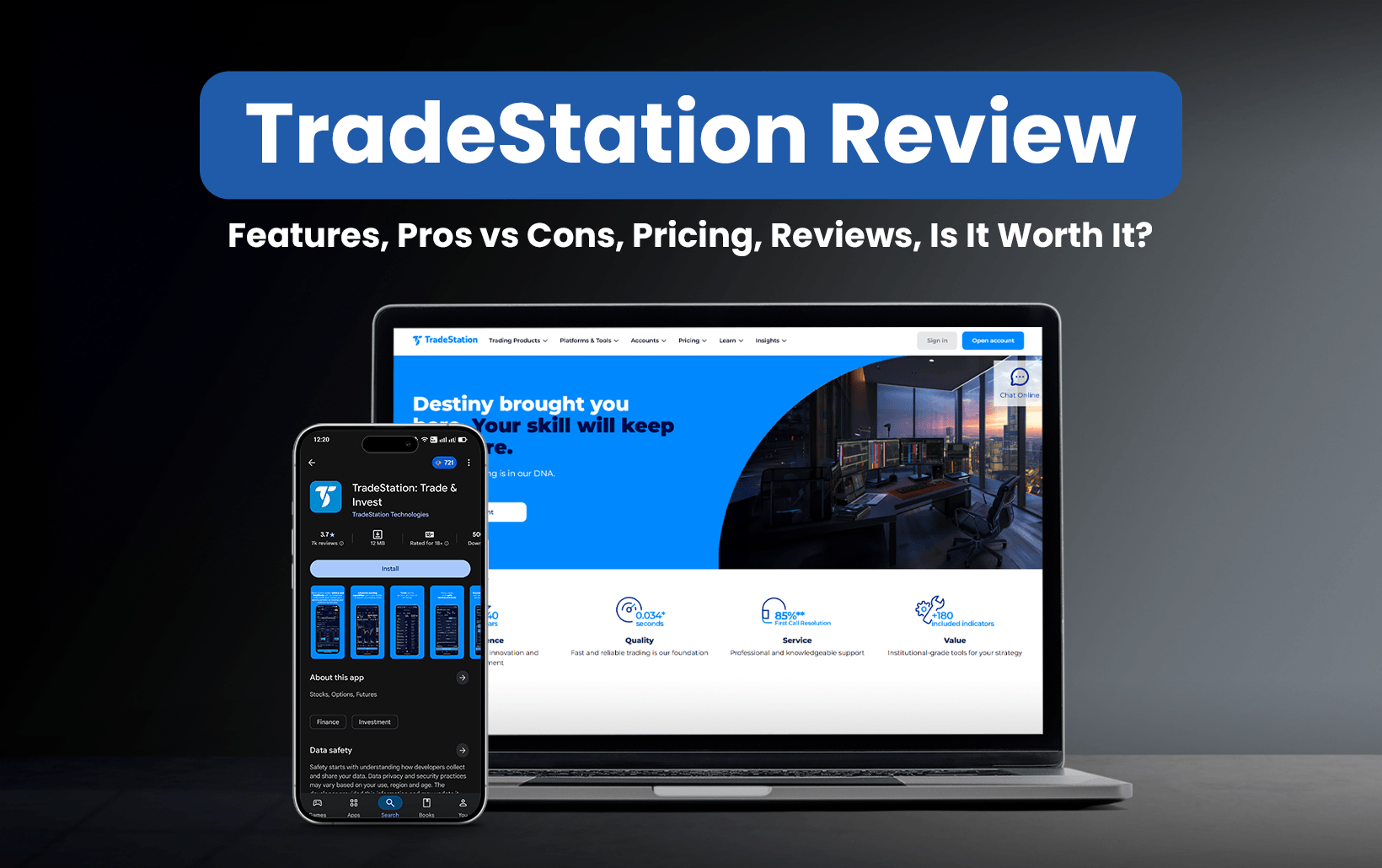
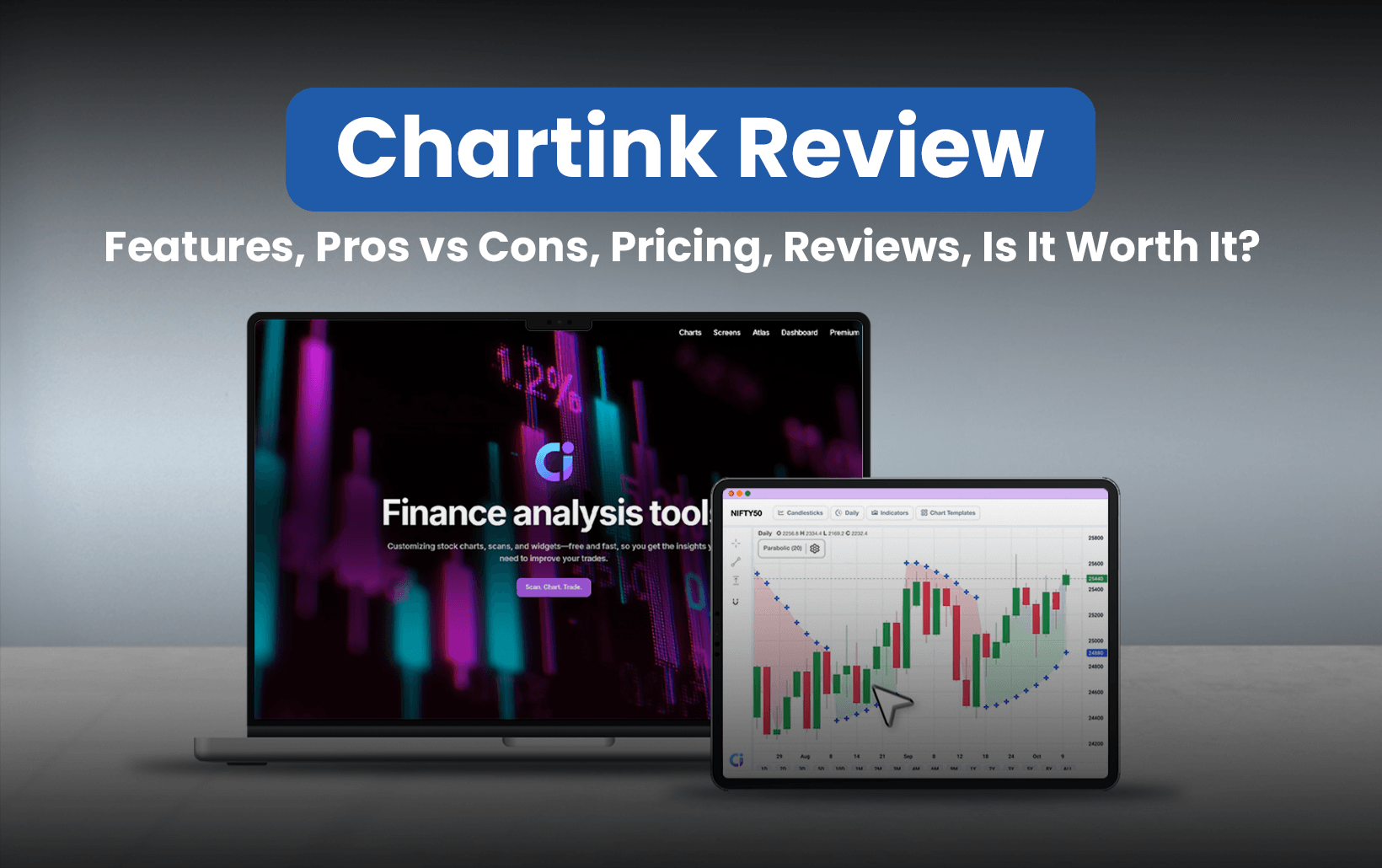
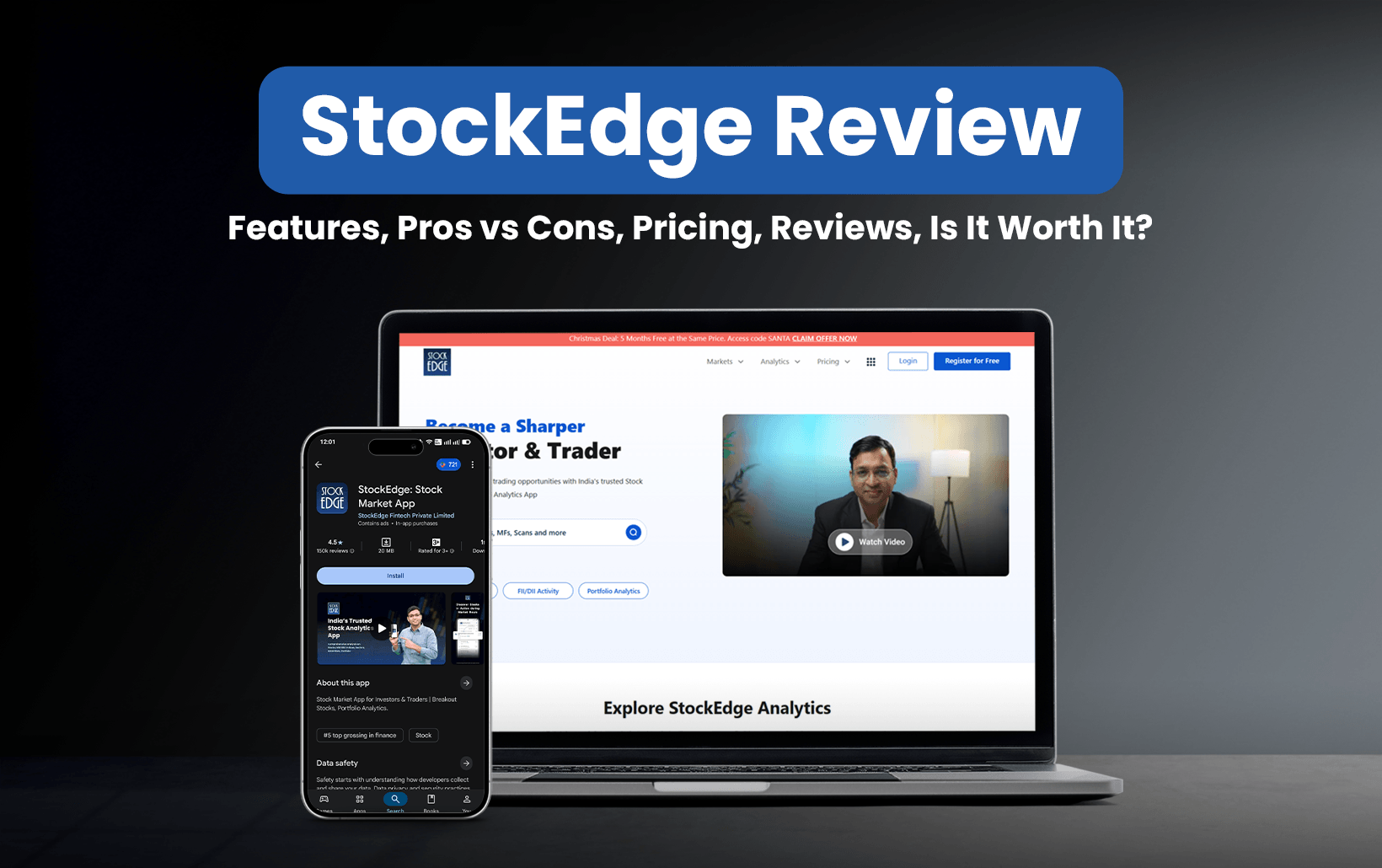
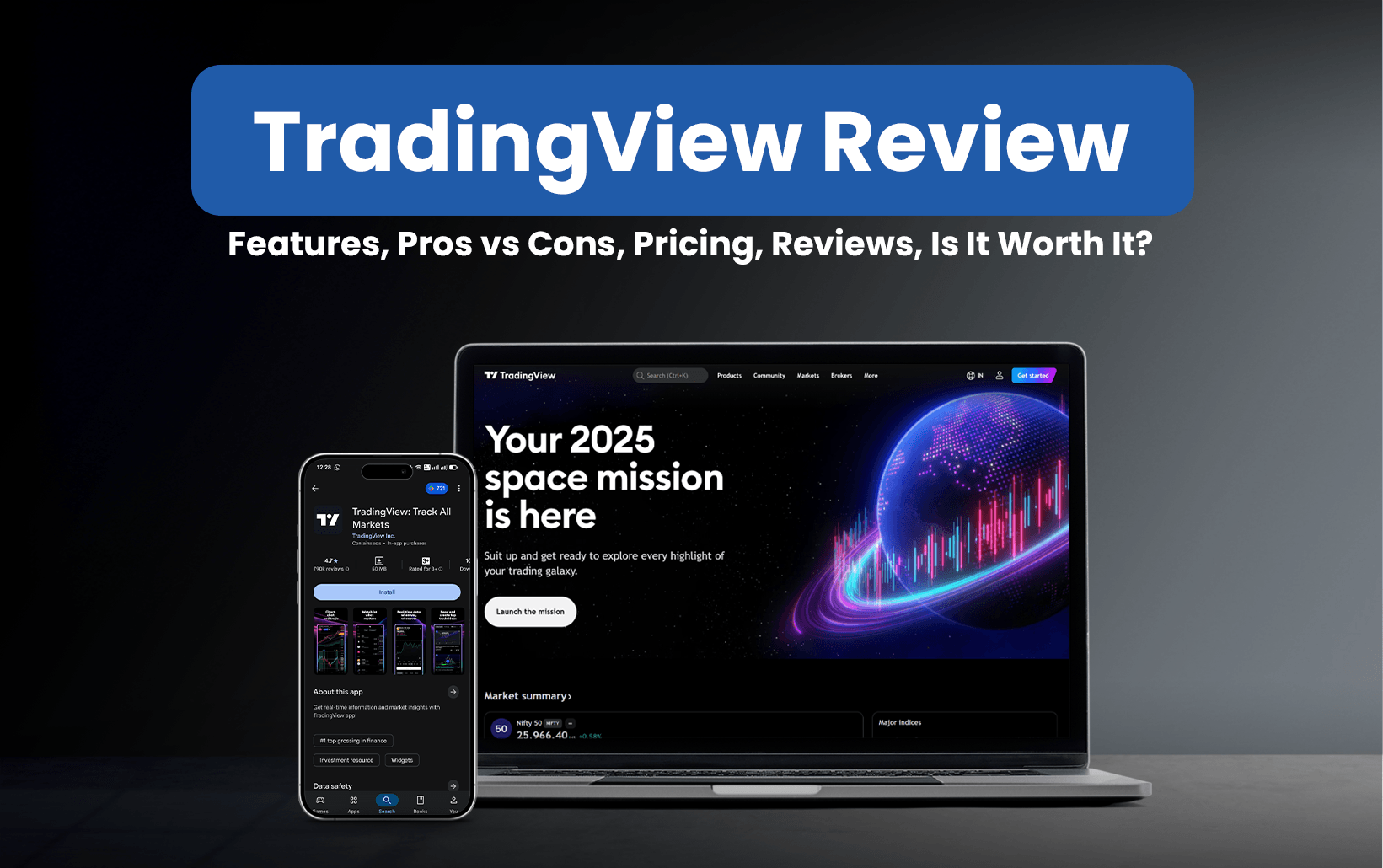
![85 Common Stock Market Terminologies for Dummies [Updated List for 2026] 19 85 Common Stock Market Terminologies for Dummies [Updated List for 2025]](https://www.strike.money/wp-content/uploads/2025/04/Popular-Stock-Market-Terms-for-Beginners-Banner.png)











No Comments Yet.